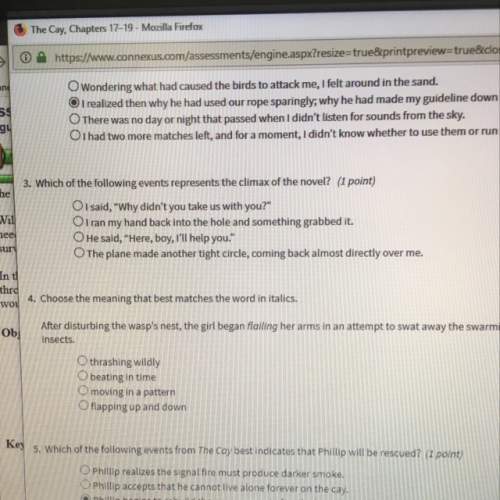
English, 26.12.2020 08:50, poweradampower
Read this excerpt from "Schenck v. U. S., 249 U. S. 47 (1919)" and answer the question that follows:
The document in question upon its first printed side recited the first section of the Thirteenth Amendment, said that the idea
embodied in it was violated by the conscription act and that a conscript is little better than a convict. In impassioned language it
intimated that conscription was despotism in its worst form and a monstrous wrong against humanity in the interest of Wall
Street's chosen few. It said, 'Do not submit to intimidation,' but in form at least confined itself to peaceful measures such as a
petition for the repeal of the act. The other and later printed side of the sheet was headed 'Assert Your Rights.' It stated reasons
for alleging that any one violated the Constitution when he refused to recognize 'your right to assert your opposition to the draft,"
and went on, 'If you do not assert and support your rights, you are helping to deny or disparage rights which it is the solemn duty
of all citizens and residents of the United States to retain.' It described the arguments on the other side as coming from cunning
politicians and a mercenary capitalist press, and even silent consent to the conscription law as helping to support an infamous
conspiracy.
Which of the following is a statement supported by the protest document?
O Deny or disparage rights
O Support an infamous conspiracy
O Silently consent to the conscription
O Do not submit to intimidation

Answers: 1
Other questions on the subject: English


English, 22.06.2019 01:50, jurnee77
Plagiarism quiz read both the paragraph below and the information following it that identifies the source using the american psychological association format. then read each of the numbered statements and determine if each is plagiarized or not. circle “yes” if the statement is plagiarized, “no” if it is not, and then fix the “yes” answers). original source the presence of the taiwanese on everest was a matter of grave concern to most of the other expeditions on the mountain. there was a very real fear that the taiwanese would suffer a calamity that would compel other expeditions to come to their aid, risking further lives, to say nothing of jeopardizing the opportunity for other climbers to reach the summit. but the taiwanese were by no means the only group that seemed egregiously unqualified. camped beside us at base camp was a twenty-five-year-old norwegian climber named peter neby, who announced his intention to make a solo ascent of the southwest face, one of the peak’s most dangerous and technically demanding routes—despite the fact that his himalayan experience was limited to two ascents of neighboring island peak, a 20,274-foot bump that required little more than vigorous walking. krakauer, j. (1998). into thin air: a personal account of the mount everest disaster. new york: anchor books, 122 - 3. student samples yes 1. there was a very real fear that the taiwanese would suffer a calamity that would compel other expeditions to come to their aid(krakauer, 1998). no) 2. many climbers overestimate their abilities, as krakauer (1998) explains when he writes of peter neby, whose himalayan experience in the past “required little more than vigorous walking” (122 - 3). no 3. jon krakauer (1998) discusses other concerns besides those of unpredictable weather and his own climbing group’s capabilities. for example the existence of a taiwanese group on everest was a matter of serious unease to most everyone else on the mountain. yes/no 4. krakauer (1998) states that the taiwanese group was not the only inexpert climbers to attempt mt. everest: camped beside us at base camp was a twenty-five-year-old norwegian climber named peter neby. . [whose] himalayan experience was limited to two ascents of neighboring island peak, a 20,274-foot bump that required little more than vigorous walking (122 – 3). yes/no 5. the author asserts that the taiwanese “were by no means the only group that seemed egregiously unqualified.” yes/no 6. in his book into thin air, jon krakauer (1998) discusses many of the dangers he noted prior to his disastrous attempt to climb mt. everest in 1996. among them were encounters with other groups and individual climbers who were ill-trained and ill-equipped to handle the demands of such a climb.
Answers: 2

English, 22.06.2019 02:40, cece5695
In virginia woolf's essay "a room of one's own," she creates a fictional sister of william shakespeare, whom she names "judith." what challenges does woolf claim this character would have experienced in her lifetime? why does woolf believe that elizabethan women did not write?
Answers: 2

English, 22.06.2019 07:30, bankscorneliuso39
M read the sentence. what best describes the underlined part of the sentence, and why? alma plans to visit london and paris, where her parentswent on their first trip together as a married couple. it is a restrictive relative clause because it begins with arelative pronoun, has both a subject and a verb, and is notnecessary to the meaning of the sentence. it is a nonrestrictive relative clause because it begins witha relative pronoun, has both a subject and a verb, and isnecessary to the meaning of the sentence. it is a restrictive relative clause because it begins with arelative pronoun, has both a subject and a verb, and isnecessary to the meaning of the sentence. it is a nonrestrictive relative clause because it begins witha relative pronoun, has both a subject and a verb, and isnot necessary to the meaning of the sentence.
Answers: 2
Do you know the correct answer?
Read this excerpt from "Schenck v. U. S., 249 U. S. 47 (1919)" and answer the question that follows:...
Questions in other subjects:


Biology, 11.01.2021 23:00

Biology, 11.01.2021 23:00





Mathematics, 11.01.2021 23:00

Mathematics, 11.01.2021 23:00







